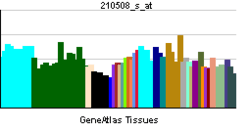KvLQT2
| View/Edit Human | View/Edit Mouse |
Kv7.2 (KvLQT2) is a potassium channel protein coded for by the gene KCNQ2.
It is associated with benign familial neonatal epilepsy.
The M channel is a slowly activating and deactivating potassium channel that plays a critical role in the regulation of neuronal excitability. The M channel is formed by the association of the protein encoded by this gene and a related protein encoded by the KCNQ3 gene, both integral membrane proteins. M channel currents are inhibited by M1 muscarinic acetylcholine receptors and activated by retigabine, a novel anti-convulsant drug. Defects in this gene are a cause of benign familial neonatal convulsions type 1 (BFNC), also known as epilepsy, benign neonatal type 1 (EBN1). At least five transcript variants encoding five different isoforms have been found for this gene.[4]
Ligands

.png)
- ICA-069673: channel opener at KCNQ2/Q3, 20-fold selective over KCNQ3/Q5, no measurable activity against a panel of cardiac ion channels (hERG, Nav1.5, L type channels, and KCNQ1) and no activity on GABAA gated channels at 10 μM. A range of related benzamides exhibited activity, of which compound number 40 is shown here.[5]
- ML252: channel inhibitor, IC50 = 70nM.[6]
References
- ↑ "Drugs that physically interact with Potassium voltage-gated channel subfamily KQT member 2 view/edit references on wikidata".
- ↑ "Human PubMed Reference:".
- ↑ "Mouse PubMed Reference:".
- ↑ "Entrez Gene: KCNQ2 potassium voltage-gated channel, KQT-like subfamily, member 2".
- ↑ Amato G, JMC Lett 2011, 481, doi:10.1021/ml200053x
- ↑ Cheung YY, Yu H, Xu K, et al. (2012). "Discovery of a series of 2-phenyl-N-(2-(pyrrolidin-1-yl)phenyl)acetamides as novel molecular switches that modulate modes of K(v)7.2 (KCNQ2) channel pharmacology: identification of (S)-2-phenyl-N-(2-(pyrrolidin-1-yl)phenyl)butanamide (ML252) as a potent, brain penetrant K(v)7.2 channel inhibitor". J. Med. Chem. 55 (15): 6975–9. doi:10.1021/jm300700v. PMC 3530927
 . PMID 22793372.
. PMID 22793372.
Further reading
- Gutman GA, Chandy KG, Grissmer S, et al. (2006). "International Union of Pharmacology. LIII. Nomenclature and molecular relationships of voltage-gated potassium channels.". Pharmacol. Rev. 57 (4): 473–508. doi:10.1124/pr.57.4.10. PMID 16382104.
- Yokoyama M, Nishi Y, Yoshii J, et al. (1997). "Identification and cloning of neuroblastoma-specific and nerve tissue-specific genes through compiled expression profiles.". DNA Res. 3 (5): 311–20. doi:10.1093/dnares/3.5.311. PMID 9039501.
- Singh NA, Charlier C, Stauffer D, et al. (1998). "A novel potassium channel gene, KCNQ2, is mutated in an inherited epilepsy of newborns.". Nat. Genet. 18 (1): 25–9. doi:10.1038/ng0198-25. PMID 9425895.
- Biervert C, Schroeder BC, Kubisch C, et al. (1998). "A potassium channel mutation in neonatal human epilepsy.". Science. 279 (5349): 403–6. doi:10.1126/science.279.5349.403. PMID 9430594.
- Yang WP, Levesque PC, Little WA, et al. (1998). "Functional expression of two KvLQT1-related potassium channels responsible for an inherited idiopathic epilepsy.". J. Biol. Chem. 273 (31): 19419–23. doi:10.1074/jbc.273.31.19419. PMID 9677360.
- Tinel N, Lauritzen I, Chouabe C, et al. (1998). "The KCNQ2 potassium channel: splice variants, functional and developmental expression. Brain localization and comparison with KCNQ3.". FEBS Lett. 438 (3): 171–6. doi:10.1016/S0014-5793(98)01296-4. PMID 9827540.
- Wang HS, Pan Z, Shi W, et al. (1998). "KCNQ2 and KCNQ3 potassium channel subunits: molecular correlates of the M-channel.". Science. 282 (5395): 1890–3. doi:10.1126/science.282.5395.1890. PMID 9836639.
- Schroeder BC, Kubisch C, Stein V, Jentsch TJ (1999). "Moderate loss of function of cyclic-AMP-modulated KCNQ2/KCNQ3 K+ channels causes epilepsy.". Nature. 396 (6712): 687–90. doi:10.1038/25367. PMID 9872318.
- Biervert C, Steinlein OK (1999). "Structural and mutational analysis of KCNQ2, the major gene locus for benign familial neonatal convulsions.". Hum. Genet. 104 (3): 234–40. doi:10.1007/PL00008713. PMID 10323247.
- Selyanko AA, Hadley JK, Wood IC, et al. (1999). "Two types of K(+) channel subunit, Erg1 and KCNQ2/3, contribute to the M-like current in a mammalian neuronal cell.". J. Neurosci. 19 (18): 7742–56. PMID 10479678.
- Shapiro MS, Roche JP, Kaftan EJ, et al. (2000). "Reconstitution of muscarinic modulation of the KCNQ2/KCNQ3 K(+) channels that underlie the neuronal M current.". J. Neurosci. 20 (5): 1710–21. PMID 10684873.
- Rundfeldt C, Netzer R (2000). "The novel anticonvulsant retigabine activates M-currents in Chinese hamster ovary-cells tranfected with human KCNQ2/3 subunits.". Neurosci. Lett. 282 (1-2): 73–6. doi:10.1016/S0304-3940(00)00866-1. PMID 10713399.
- Selyanko AA, Hadley JK, Wood IC, et al. (2000). "Inhibition of KCNQ1-4 potassium channels expressed in mammalian cells via M1 muscarinic acetylcholine receptors.". J. Physiol. (Lond.). 522 (3): 349–55. doi:10.1111/j.1469-7793.2000.t01-2-00349.x. PMC 2269765
 . PMID 10713961.
. PMID 10713961. - Cooper EC, Aldape KD, Abosch A, et al. (2000). "Colocalization and coassembly of two human brain M-type potassium channel subunits that are mutated in epilepsy.". Proc. Natl. Acad. Sci. U.S.A. 97 (9): 4914–9. doi:10.1073/pnas.090092797. PMC 18332
 . PMID 10781098.
. PMID 10781098. - Schwake M, Pusch M, Kharkovets T, Jentsch TJ (2000). "Surface expression and single channel properties of KCNQ2/KCNQ3, M-type K+ channels involved in epilepsy.". J. Biol. Chem. 275 (18): 13343–8. doi:10.1074/jbc.275.18.13343. PMID 10788442.
- Main MJ, Cryan JE, Dupere JR, et al. (2000). "Modulation of KCNQ2/3 potassium channels by the novel anticonvulsant retigabine.". Mol. Pharmacol. 58 (2): 253–62. PMID 10908292.
- Wickenden AD, Yu W, Zou A, et al. (2000). "Retigabine, a novel anti-convulsant, enhances activation of KCNQ2/Q3 potassium channels.". Mol. Pharmacol. 58 (3): 591–600. PMID 10953053.
- Tinel N, Diochot S, Lauritzen I, et al. (2000). "M-type KCNQ2-KCNQ3 potassium channels are modulated by the KCNE2 subunit.". FEBS Lett. 480 (2-3): 137–41. doi:10.1016/S0014-5793(00)01918-9. PMID 11034315.
- Smith JS, Iannotti CA, Dargis P, et al. (2001). "Differential expression of kcnq2 splice variants: implications to m current function during neuronal development.". J. Neurosci. 21 (4): 1096–103. PMID 11160379.
- Miraglia del Giudice E, Coppola G, Scuccimarra G, et al. (2001). "Benign familial neonatal convulsions (BFNC) resulting from mutation of the KCNQ2 voltage sensor.". Eur. J. Hum. Genet. 8 (12): 994–7. doi:10.1038/sj.ejhg.5200570. PMID 11175290.
External links
- KCNQ2 Potassium Channel at the US National Library of Medicine Medical Subject Headings (MeSH)
This article incorporates text from the United States National Library of Medicine, which is in the public domain.


